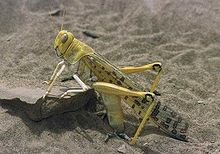Desert locust
| Desert locust | |
|---|---|
 |
|
| Scientific classification | |
| Kingdom: | Animalia |
| Phylum: | Arthropoda |
| Class: | Insecta |
| Order: | Orthoptera |
| Family: | Acrididae |
| Genus: | |
| Species: | S. gregaria |
| Binomial name | |
|
Schistocerca gregaria Forsskål, 1775 |
|
The desert locust (Schistocerca gregaria) is a species of locust. Plagues of desert locusts have threatened agricultural production in Africa, the Middle East, and Asia for centuries. The livelihood of at least one-tenth of the world’s human population can be affected by this voracious insect.
The desert locust is potentially the most dangerous of the locust pests because of the ability of swarms to fly rapidly across great distances. It has two to five generations per year. The last major desert locust upsurge in 2004–05 caused significant crop losses in West Africa and had a negative impact on food security in the region. While the desert locust alone is not responsible for famines, it can be an important contributing factor.
The life cycle of the desert locust consists of three stages, the egg, the nymph known as a hopper, and the winged adult. Copulation takes place when a mature male hops onto the back of a mature female and grips her body with his legs. Sperm is transferred from the tip of his abdomen to the tip of hers, where it is stored. The process takes several hours and one insemination is sufficient for a number of batches of eggs.
The female then seeks suitable soft soil in which to lay her eggs. It needs to be the right temperature and degree of dampness and be in close proximity to other egg-laying females. She probes the soil with her abdomen and digs a hole into which an eggpod containing up to a hundred eggs is deposited. The egg pod is 3 to 4 cm (1.2 to 1.6 in) long and the lower end is about 10 cm (4 in) below the surface of the ground. The eggs are surrounded by foam and this hardens into a membrane and plugs the hole above the egg pod. The eggs absorb moisture from the surrounding soil. The incubation period before the eggs hatch may be two weeks or much longer, depending on the temperature.
The newly hatched nymph soon begins to feed and, if it is a gragarious individual, is attracted to other hoppers and they group together. As it grows it needs to moult (shed its exoskeleton). Is hard cuticle splits and its body expands while the new exoskeleton is still soft. The stages between moulting are called instars and the desert locust nymph undergoes five moults before becoming a winged adult. Immature and mature individuals in the gregarious phase individuals form bands which feed, bask and move as cohesive units, while solitary phase individuals do not seek gregariousness.
...
Wikipedia

